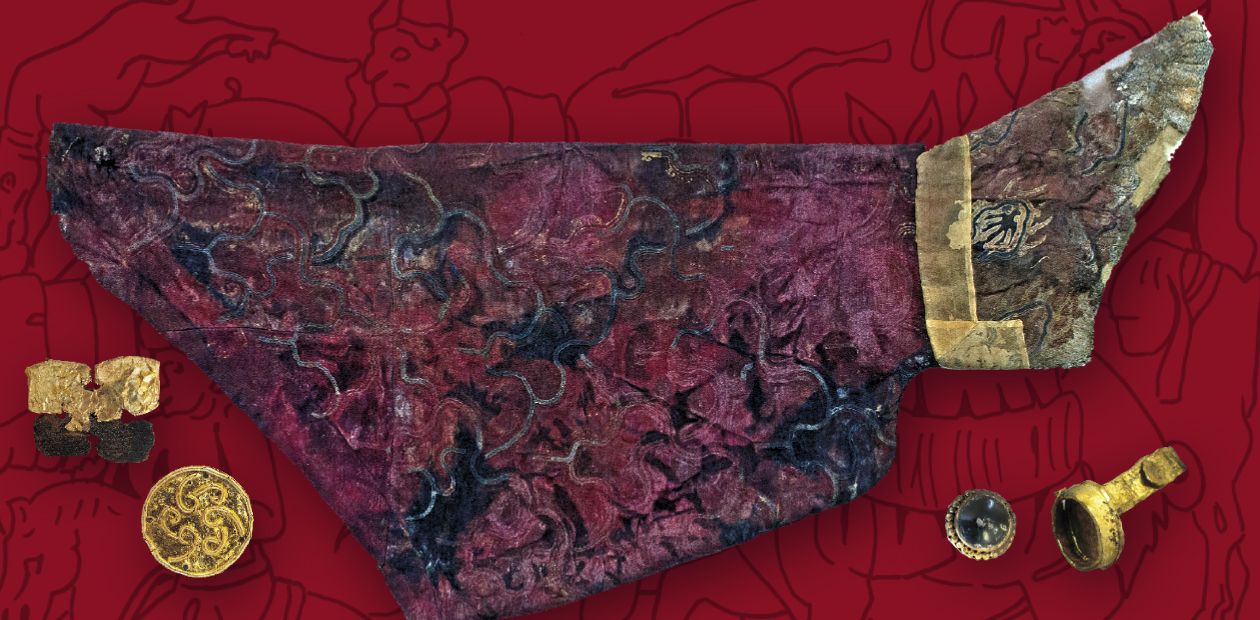Steppe Fashion. Items from the Wardrobe of Ancient Nomads
For most of us, the word Xiongnu bears an association the Huns, the nomadic tribes whose raids terrified the Ancient Rome. In fact, the Xiongnu do have a "genetic relationship" with the Huns. All we know about this legendary nation of the past, who created the world's first nomadic empire, known mostly from the ancient chronicles its great neighbor, the Chinese Han Empire. The source of important information on the history and culture of the Xiongnu, as well as all ancient civilizations of Central Asia, China, and the Middle East, are the tumuli of Noin-Ula in the northern Mongolia, where noble representatives of this nomadic nation were buried about 2,000 years ago.
In 2012, during excavations of Tumulus 22 in Noin-Ula, which had been robbed in ancient times, the Russian-Mongolian archaeological expedition discovered a large number of original items, including unique textiles. Of the steppe leader’s costume, which was decorated with truly barbarian pompousness, only his leggings—unstitched pant legs attached to a belt—were more or less intact. The leggings, which were made of purple fabric embroidered with silk and ended with felt boots, were likely worn over simple silk or woolen pantaloons and served as a fancy clothing item. The dye, the plain weave, the quality of the seams and embroidery, and the shape of the patterns suggest that this textile items reflects the fashions and technological trends of three different cultures of that time
This article continues a series of publications on the unique results of archaeological excavations at the burial sites of the Xiongnu nomads, which are carried out by the Russian–Mongolian expedition in the Noin-Ula mountains in the north of Mongolia. In 2012, archaeologists explored Tumulus 22, in which a high-ranking Xiongnu was buried around 2000 years ago (from the end of the 1st century BC to the beginning of the 1st century AD). Although the burial pit was as deep as 16 m, the tumulus had been robbed already in ancient times. Nonetheless, researchers found a large number of artifacts, including unique textile items, which have become a source of valuable information on the history and culture of the ancient civilizations of Central Asia, China, and the Middle East
It was another crumpled bundle of cloth, almost indistinguishable, as it was sodden with gray-blue clay, which was used by the Xiongnu to fill the space between the walls of the burial pit and wooden burial chamber. Over the years, this fine clay, which had been intentionally brought here from the lake, slipped in between the logs of the burial structure into the corridors and inside the vault, forming a thick layer on the floor and on all the items found on the floor. The textile bundle was lying next to the western wall of the coffin, which itself was in a very good condition, except for the cover, which had been pried off by robbers.
The textile bundle was delivered to the Institute of Archaeology and Ethnography SB RAS (Novosibirsk, Russia) for laboratory studies. When Elena Shumakova, a restorer and artist, began to work with the artifact, the first thing she noted was the good condition of the cloth. Yes, it was old and dirty, but not shabby. Already during the cleaning process, the cloth began to gleam in, although faded, yet still bright and rich dark red color...
Noble red
UNDER THE SACRED QUATREFOIL The coffin discovered in Tumulus 22 of Noin-Ula was made, according to the Chinese tradition, of pine boards tied by butterfly-like fasteners. Moreover, the sidewalls were attached to the bottom with iron nails, six on each side. The coffin was decorated with silk fabric, on top of which was a rhombic mesh of flat wooden planks covered with thick gold foil. Inside each rhombus, there was a quatrefoil rosace, which was also made of wood and covered with gold foil. This decor was assembled using small gold studs. Robbers tore all the decorations off the coffin and, having grabbed all the gold, threw wooded pieces onto the floor of the burial chamber, where they were discovered by archaeologists along with fragments of lacquerware—cups and a table.Decorations in the form of a rhombic mesh with quatrefoil rosaces were found in almost all of the presently known Xiongnu coffins. They were made of bronze and iron and, sometimes, even of birch bark. The origins of this ornamental tradition date far back to the ancient China. The quatrefoil ornament, known in the literature as a “persimmon stem,” appeared already during the reign of the Zhou dynasty and reach its peak at the time of the Han, when it spread from sacred objects to routine ones. This pattern was used to decorate dishes, mirrors, murals, tiles, clothes, etc., as well as coffins, the last “home” of the Xiongnu. For example, the cover of the coffin from Burial Site 1 in the province of Henan, which dates back to the period of the Western Han, has a lacquer ornament with “grass and leaves, persimmon stems (quatrefoil)” (Kaogu, 2001).
Analyzing the ideas underlying this popular symbol and tracing its evolution, the Chinese researcher Liu Daoguan came to the conclusion that its origin is related to the shape of the sign hou (target). Shooting at a target was a major ritual of the Son of Heaven (emperor); ordinary people were not allowed to participate in this ritual. According to Daoguan, this explains why the quatrefoil gradually lost its original symbolism and evolved into the various forms. The very mention of the “persimmon stem” appeared only during the Tang dynasty, when no one knew the symbol’s meaning (Daoguan, 2011). The meaning of the pattern decorating the coffin in Tumulus 22 was to protect the body from hostile supernatural forces and contribute to its resurrection.
The silk fabric that covered the coffin was, most likely, a piece of cloth sewn from different fragments. Silk covered almost all of the presently known Xiongnu coffins: the tradition to use silk covers on coffins had been typical of the Western Zhou, with the fabric being often embroidered with beautiful patterns.
Inside, the coffin was empty. Apparently, all that was left from the rich burial was subtle dust from the mat and millet grains, among which researchers discovered a few small gold plaques and fragments of gold items. But it was a false impression. The intact corridors between the inner and outer burial chambers contained things that the deceased would need in the other world—unique witnesses of the man’s life and the legendary era. Outside of the inner chamber in the eastern corridor, researchers also discovered a few scattered bones of the deceased, which were subsequently subjected to genetic analysis to find that a man, not a woman, was buried in Tumulus 22 (Pilipenko et al., 2013)
Researchers from the Institute of Organic Chemistry SB RAS (Novosibirsk) V. I. Mamatyuk, E. V. Karpova, and V. G. Vasiliev analyzed the textile from Tumulus 22 was to find that several types of dyes of plant and animal origin—alizarin, purpurin, and laccaic acids—were used to dye the textile.
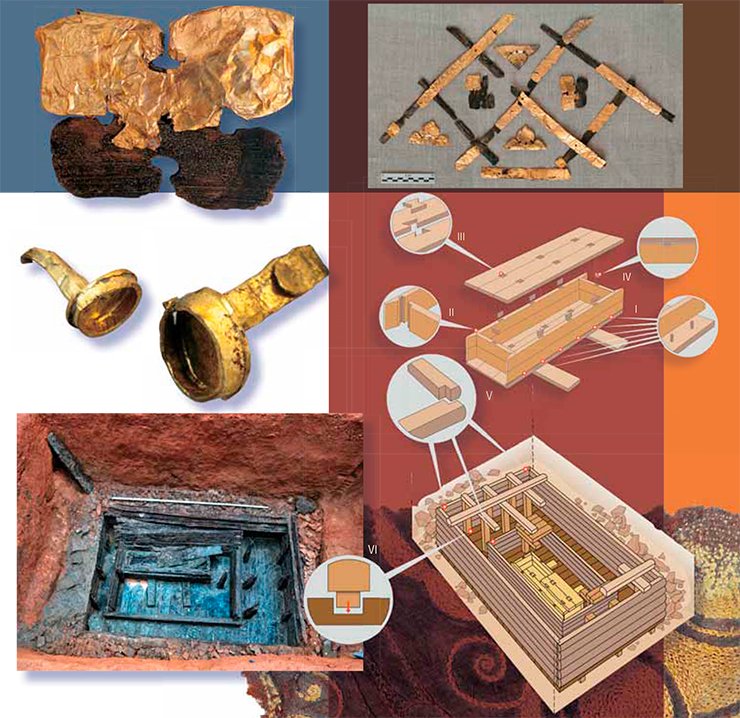
The ancient people highly valued cloths treated with several dyes to achieve the desired color. The source of laccaic acid, the most exotic dye, was lac bugs, a species of scale insects of the Kerriidae family, which live in trees in Bhutan, Nepal, Burma, Laos, Cambodia, Vietnam, Thailand, and southern China (Yunnan) as well as in most parts of India and Ceylon. Mediterranean peoples had known this lac since antiquity: merchants delivered it together with cotton cloths from the northwest coast of India to Egypt and from Egypt to the Eastern Mediterranean. Archaeologists have found woolen cloths dyed with laccaic acid in the burial sites of Palmyra, one of the richest cities in late antiquity, among items belonging to the wealthiest strata of society (Bohmer and Karadag, 2000).
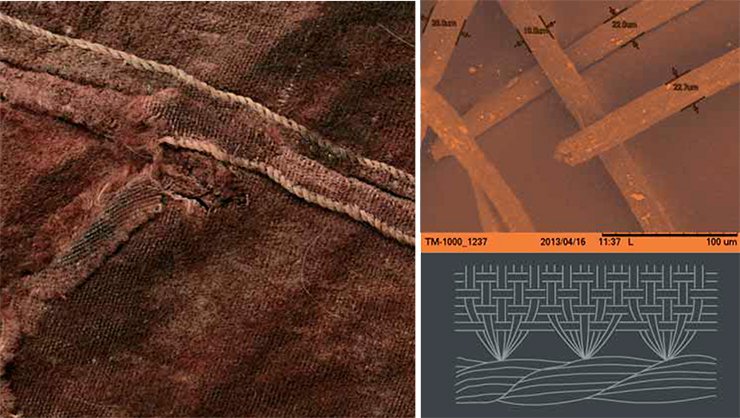
In the Palmyra necropolis—the stone mausoleums of noble Palmyrians, archaeologists discovered textiles, mainly in the form of long strips, which were used for wrapping mummified bodies. The finds include fragments of most colorful Parthian patterned clothes as well as plain Roman tunics and robes
In Han China, silk cloths were dyed in all shades of red using dyes produced from cultivated plants (madder and safflower); another popular substance was the mineral dye cinnabar, or mercury sulfide (Lubo-Lesnichenko, 1961). Chinese written sources of the Zhou Han periods (1027 BC to 220 AD), which contain extensive data on cloth dyeing in ancient China, make no mention of lac bugs. Special studies of Han silk cloths found no traces of a dyeing substance obtained from lac bugs (Kononov, 1946; Bohmer and Karadag, 2000). It was much later that the Chinese began to use lac for dyeing; the reliable written evidence dates back to the early 4th century AD.
Textiles are a unique find for archaeologists. The reason is not only that they are rare, but also that in ancient times, textiles and the weaving process itself were endowed with much more value than we can imagine. Ancient people often saw the world as a woven fabric in which all human lives are fixed in a predetermined patternThe analysis of the textile collection from the Noin-Ula tumuli (Mongolia), which was obtained during the excavations of 2006—2013, as well as the cloth samples from P. K. Kozlov’s excavations, which are kept at the Hermitage (St. Petersburg), showed that a large part of the best quality woolen cloths were dyed using laccaic acid. This is additional evidence that the woolen cloths from the Xiongnu tumuli of Noin-Ula were produced and dyed far away from China and Central Asian steppes—somewhere from Northwestern India, the place of origin of the dyeing substance, to the Eastern Mediterranean, where the fabric itself was likely weaved.
The fabric was made from high-quality fleece with a fiber diameter of 21 microns. The fabric has retained its original properties such as lightness, elasticity, softness, fineness, and strength. Each thread of the warp is double and has a light brown color (the natural color of the original material); that of the weft is single and red. The color differences suggest that dyeing had been applied to the raw yarn, not the finished textile. The technological feature of the fabric is that the number of warp threads is less than those of the weft, which is why it is virtually impossible to see the warp. This weaving technique is known from the well-studied Palmyra materials as weft-faced plain weave, which is used to make especially strong fabrics (Stauffer, 2000).
These textiles had a range of technological features formed during the weaving. Thus, weavers applied an original technique to fix the beginning and end of a piece of cloth: the cut warp yarns at the upper and lower edges of the cloth were drawn through the so-called tension cord (Stauffer, 2000). These features, known from the Palmyra textiles, were also identified in the woolen cloth fragments from Tumulus 22, Noin-Ula. These data are compelling evidence that the cloth had come from Mediterranean weaving workshops.
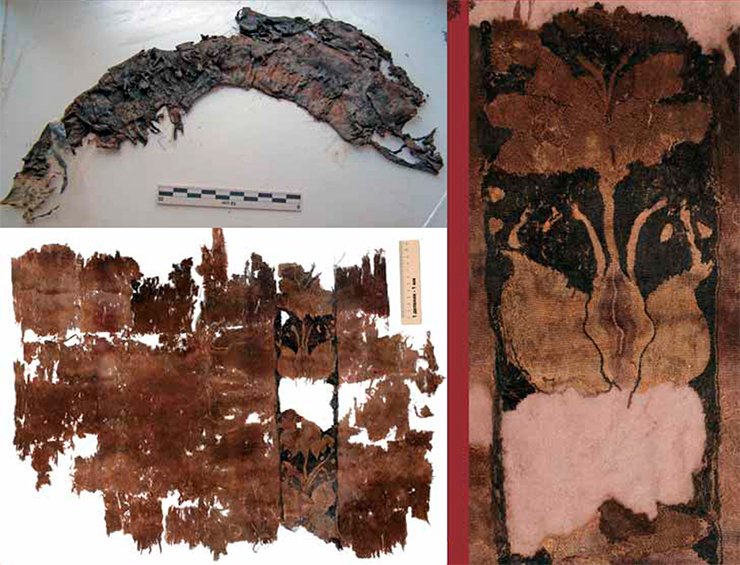
The first sample is a piece of cloth on which there are five bands with an alternating pattern, which are woven in a tapestry technique. The central band depicts two twining ivy stems with motley leaves; on each side of it, there are bands with a “traveling-wave” pattern. Toward the edges of the cloth, there are two more ornamental bands with fragments of images of flowers or fruits.
The second fragment proved to be identical to another Noin-Ula finding, the one from the Kondratiev tumulus (Rudenko, 1962). That piece of cloth also had alternating ornamental bands with patterns of a traveling wave and flowers (most likely, poppies).
Both of the Noin-Ula findings are of excellent quality and craftsmanship. Similar textiles have been discovered at Palmyra; there is also evidence of numerous images of clothing items (the so-called Palmyra costume) decorated with similar bands with a floral pattern. In the east, a similar textile was discovered in the northern segment of the Silk Road, in the ancient Loulan Oasis (in what is now Xinjiang).
Given all the stylistic similarities, these textiles cannot be considered identical. The Noin-Ula textiles are remarkable in the exquisite fineness of the patterns and the mild transitions between colors, which is reminiscent of painting. In this respect, the Noin-Ula findings are most similar to the textiles from the Scythian tombs of the Black Sea region, which are currently known only from photographs and descriptions
In their place of origin, pieces of these textiles were themselves used as clothing items such as tunics, veils, and robes. Importantly, the textile pieces were used in the mummification of deceased nobles in Palmyra and Dura-Europos. They were placed into the tombs, where they were subsequently discovered by archaeologists.
Silk embroidery on wool
…Researchers did not immediately realize that the Noin-Ula findings were not isolated textile pieces, but a single clothing item—leggings, i.e., “unstitched” pants consisting of two pant-legs, each worn separately and fixed with a strap placed over the outer garments. The threads of the seams joining the pieces had decayed, and the item fell apart into two large and five small fragments. Researchers found that one of the “legs” was sewn of three pieces and the other one of four pieces. Doctor of History T. N. Glushkova (Surgut State Pedagogical University, Surgut, Russia), an expert in archaeological textiles, found that the maximum possible length and width of the textile from which the leggings were cut, was no less than 180 and 91 cm, respectively. The cloth fragments were sewn together along the warp, suggesting that the tailor knew well the characteristics of the textile.
In the upper part of each “pant-leg,” there are special cuts through which it was tied to the strap. The cloth in these places is deformed (stretched along the warp), which is a sign of wear; perhaps, this part had unpreserved precious decorations. The leggings ended with felt boots covered with embroidered woolen cloth; the boots and the legs made a single whole.
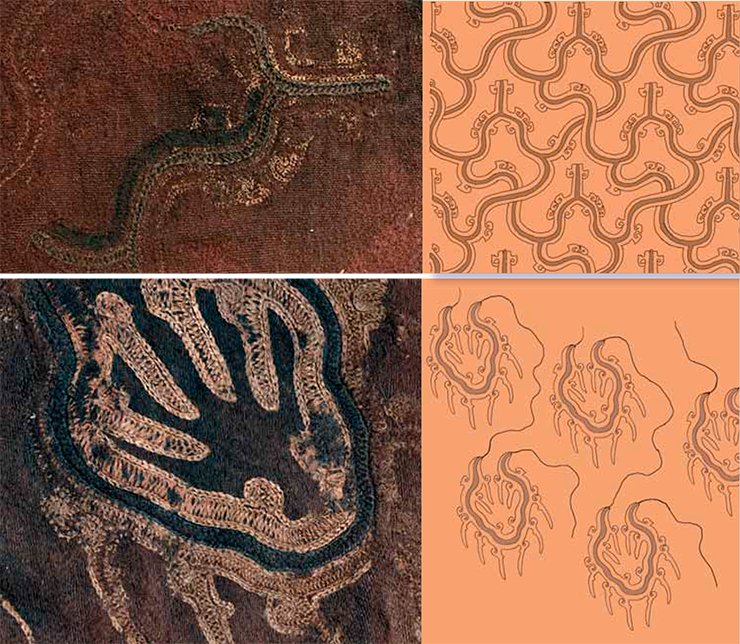
The restorers put the items together quite easily. In so doing, they discovered an interesting fact: the silk embroidery was made after all the pieces were sewn together, which means that the embroiderers worked with the finished items, not the cloth itself.
Although the threads used for the embroidery had disappeared (decayed) almost entirely, the cloth retained a visible imprint of the embroidered pattern. The small remaining fragments of the embroidery allow researchers to restore the entire pattern. A similar pattern, which was made using threads of three colors—sand and two shades of brown, was discovered on the undyed silk fabric of the footwear covers found at Tumulus 24, Noin-Ula by Kozlov’s expedition. The pattern itself, researchers believe, is an abstract stylized mountain landscape (Lubo-Lesnichenko, 1961).
Fragments of the ancient textile item: what could they tell us?
This one piece of cloth is literally an outcome of amalgamation of two cultures to satisfy the needs of a third one. Syrian weavers with their lasting tradition of textile production made an excellent-quality woolen fabric, which was then dyed with an Indian dye. Then, together with other expensive fabrics, it traveled with a trade caravan to the far-away China, where these goods were highly valued at the Han court and were to be exchanged for Chinese silks, already well known in the Mediterranean markets.
Goods followed long and dangerous roads, through deserts and mountain passes, and changed many hands before they finally arrived in the city of Chang’an, which had been the capital of the Western Han until 25 AD. Unless, of course, the caravan had been captured by the Xiongnu somewhere in the Western Territory (the present-day territory of Xinjiang), as this part of the Silk Road was controlled by the nomads, or had been sent to the Xiongnu as a legitimate tribute.
One way or another, the beautiful woolen cloth had served its purpose, i.e., was used to sew originally designed leggings. There is something, perhaps the durable seams made using double coarse woolen threads, that suggests that this item was made not at the Han court’s workshops, but at the shanyu’s (a Xiongnu leader) headquarters. Evidently, the leggings were designed and sewn together by a local skillful tailor. But the embroidery was definitely done by a Chinese craftswoman: such a sophisticated, typically Han pattern, which was reproduced from a template, could have been so impeccably embroidered only by a highly experienced person, who was familiar with multicolored silk embroidery since childhood. Incidentally, the embroidery itself—silk on wool—is a unique phenomenon for the period being studied, i.e., for the early 1st century AD.
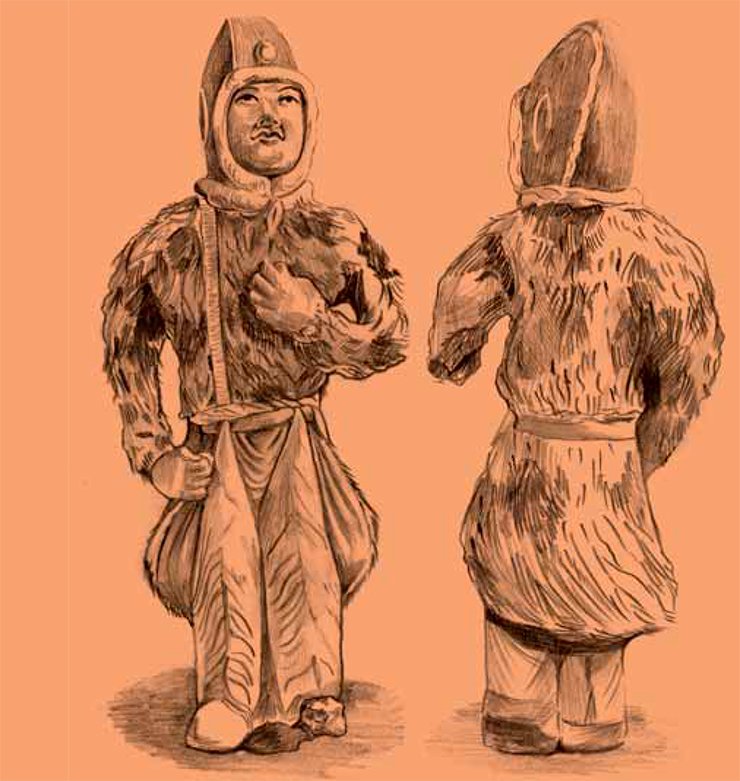
The one for whom these leggings had been sewn had worn them long enough before heading into another world. This is evidenced by the worn out shoe soles stitched to the pant-legs and the “napped” fabric itself, which began to resemble broadcloth. The leggings were also damaged by robbers. Apparently, they were pulled off the man’s body lying in the coffin and thrown onto the carpeted floor of the wooden burial chamber, where they were found 2,000 years later.
The “barbarian” pants
What was the purpose of this unusual clothing item? How did Xiongnu wear them? Leggings were likely worn over simple (non-ornamented) silk or woolen pantaloons. Being a fancy item, they were worn for decoration rather than protection against dirt and cold.
Similar leggings sewn from patterned Chinese silk were found at Tumulus 6 in Noin-Ula by Kozlov’s expedition. Those “pant-legs” have a red silk lining without a pattern and end with felt boots having short tops. The length of those leggings from the waist to the heel is about 1 m, and their width is 0.5 m. The silk design from Tumulus 6 emphasizes the decorative nature of this clothing item: so wide and light “pant-legs” can neither protect nor warm, but certainly look fancy when put on top of woolen pantaloons. Perhaps, this part of the outfit was worn only by cavalry because wearing leggings with soft felt boots would not have been particularly convenient for those walking on foot.
It should be noted that pants had been nomads’ typical clothing since antiquity; moreover, they were a major distinct feature of barbarians in ancient literature (Rickman, 1986). The Chinese took over this clothing early enough because they had always had contacts with nomadic tribes in the north. Already during the reign of the Zhou emperor Ling Wang, the Chinese army adopted the barbarian rider’s outfit, with pants being the most unusual part of it. There was even a debate at the court on whether barbarian clothes should be adopted. The emperor said that he had no doubts about the necessity of borrowing barbarian clothes, but was afraid that tianxia would laugh at him (from The Records of the Grand Historian by Sima Qian).
However, the emperor’s will and expediency considerations prevailed, and pants became an integral part of the Chinese rider’s outfit. According to the Noin-Ula findings, both the Xiongnu and the Western Han Chinese wore the same pants and leggings.
As regards leggings, researchers believe that these unstitched pant legs attached to a belt marked the beginning of the evolution of pants as they trace the existence of leggings in a variety of cultures and regions (Morozov, 1989; Lobacheva, 1989).
Thus, judging by the article kept at the State Ethnographic Museum (St. Petersburg, Russia), Azerbaijani women wore similar “pants” at the end of the 19th century. Ethnographic materials from Central Asia (children’s pants in the form of unstitched leggings) and the Turkish term for pants—ayakton (legwear) may suggest that pantaloons made of two unstitched pant-legs could have been worn in this region not long ago. Leggings are also known to be a component of both children’s and adults’ traditional outfits of the Nanai people (Lobacheva, 1989).
It is possible that the lower-body clothing of the ancient Chinese, which is termed ku, also looked like separately worn pant-legs. The discovery of the silk leggings at Tumulus 6 in Noin-Ula seems to have provided material evidence for this idea. Anyway, L. P. Sychev and V. L. Sychev, who have long investigated the Chinese costume, believe that the leggings from the tumulus were clearly of a Chinese origin. Moreover, separate pant-legs made of cotton-padded cloth, which were fastened to a strap using ribbons (the modern term for this clothing item is taoka, literally, a cover for pants), were still worn in China at the end of the previous century during cold seasons on top of quilted pants for warmth (L. P. Sychev and V. L. Sychev, 1975).
Separately worn unstitched pant-legs appear to have been very typical of ancient Iranian peoples, i. e., Persians, Scythians, and, perhaps, some Sarmatian tribes. This thesis seems to be confirmed by artistic sources as well as written evidence (Ravdonikas, 1990). Images of Sasanian horsemen show pants that are very similar to those worn by the Xiongnu. Interestingly, one of the Chinese burial complexes in the Shanxi province, which dates back to about the same epoch, i.e., the first half of the 7th century AD (the Tang dynasty), was found to contain three clay figurines of horsemen whose outfit was visibly different from that worn by the Chinese cavalry and included individual pant-legs strapped to the belt. Both the horsemen’s and the Sasanian king’s leggings are covered with a tiger-skin pattern.
Steppe leader’s wardrobe
Speaking about the clothes found in Tumulus 22, it was only the leggings that were more or less intact; researchers found only small fragments of the other clothes of the buried man. However, these findings would allow researchers to reconstruct almost all of the man’s rich outfit. First of all, he had a solid-colored silk robe with silk wadding and another one made of red silk polychrome fabric trimmed with sable fur. Moreover, he had a sable fur-coat: archaeologists found only some fragments of the fur; the skin did not survive. In China, by the way, silk robes were worn on top of fur coats, and Xiongnu nobles could have worn those garments in a similar manner.
The silk garments had an intriguing decoration—turquoise kingfisher feathers tied in small bunches with gold foil. It is known that since ancient times, the Chinese used this bird’s feathers for decorating people’s attires and homes, e.g., clothes, jewelry, canopies, and awnings. During the Han’s reign, this decorative element was closely associated with the Taoist symbolism: it was a sign of a “full-fledged” Taoist, i.e., an immortal. According to written sources, Taoists even had clothing items made entirely of feathers (Schaefer, 1981). Feathers were used to decorate aristocrats’ garments. The fact that the Xiongnu had silk garments decorated with bunches of bright kingfisher feathers suggests that the contemporary Chinese fashion penetrated into the steppe, and the Xiongnu leaders could acquire fashionable items that were available only to a limited circle of Chinese nobility.
Tumulus 22 also contained finest black lacquer gratings with silk threads inside; these items proved to be fragments of a guan, i.e., a headpiece made of hemp or silk fabric soaked with lacquer. This headpiece was a sign of ethnic affiliation and “civility” (Kravtsov, 2004). Chinese sources mention nineteen different kinds of guan. The earliest lacquered gas guan was discovered at the Mawangdui burial site in China (Wang Shujin, 2008).
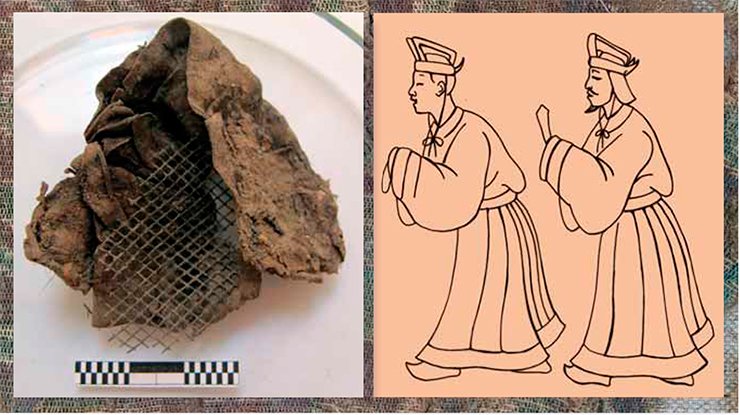
This headpiece, whose remnants with a set of tortoiseshell hairpins were found in Tumulus 22 of Noin-Ula, was likely granted to the shanyu by the Chinese emperor. In the steppe, this decoration must have been completely useless yet prestigious, which is why it was discovered, together with the other equally useless gifts of the Han court (such as a ceremonial umbrella), in the Xiongnu noble’s burial.
Thus, owing to Chinese gifts, which included finished items as well as textiles, the Xiongnu nobility dressed in a rather peculiar manner, combining the traditional horseman’s pants with Chinese robes and, sometimes, headpieces. This resulted in an eclectic dressing style, which was emphasized with ornaments.
Today we cannot recreate the full look of this costume, but the presence of small gold plaques decorated with Chinese-style ornaments is evidence that, according to the “barbarian” tradition of the steppe, the buried man’s outfit was heavily embroidered with gold. The buckles were covered with finest delicate gold plating; the thimbles of the narrow belts were made of gold and silver. Turquoise was used for inserts in gold jewelry; the decorations also included amber and pyrite-crystal beads and agate and jade suspensions.
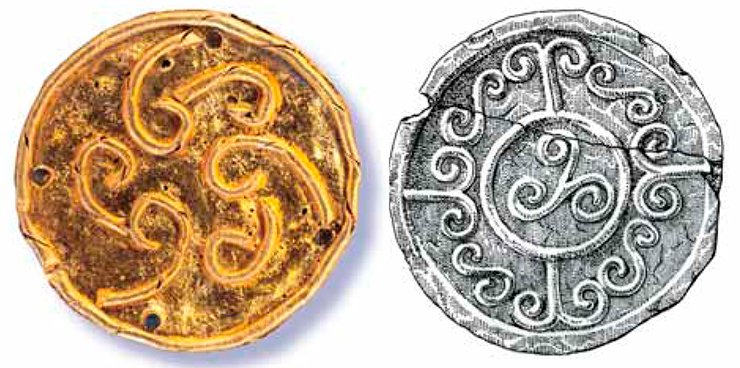
Judging by the quantity of the excellent silk fabrics, fragments of unique lacquer objects, such as a table on curved legs and a Chinese ceremonial umbrella, silver decorations with unicorns’ images on the horse harness, remnants of a Chinese chariot, and many other precious objects, the man buried in Tumulus 22 belonged to the highest stratum of the Xiongnu nobility. The nobility who enjoyed all the benefits coming from that section of the Silk Road that was controlled by the Xiongnu and, hence, all the gifts of the Han court, which was at its prime in those days.
Clothes have always been an important indicator of ethnic affiliation by uniting people of one community. The nomads’ outfit must have been strikingly different from that worn by farmers on China’s Central Plains. However, while there is extensive evidence about the wardrobe of the Han Chinese, which comes from written, pictorial, and even archaeological sources, the Xiongnu’s clothes remain a mystery.
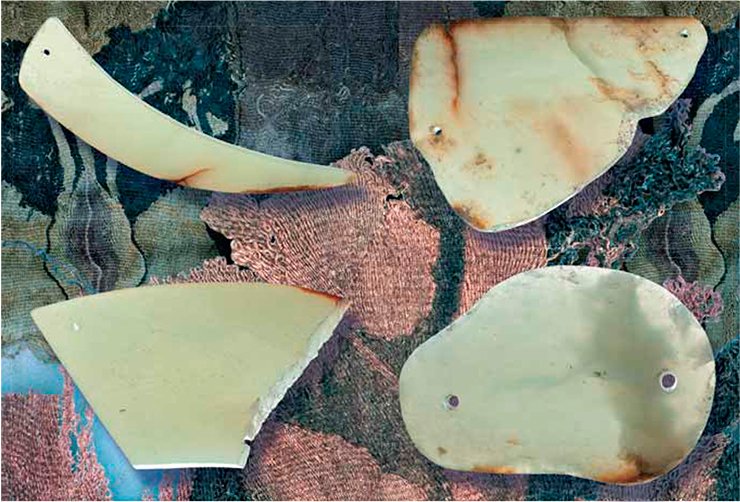
There is very little written evidence left by contemporaries about the Xiongnu’s appearance. The Hans were critical about the nomads: “The barbarians are selfish and rent-seeking; they do not do their hair and wear their clothes right over left; they have the face of a man and the heart of a wild beast...” (Materials on the history..., 1989, p. 14).
These texts give little clue to how the nomadic Xiongnu actually looked like. The only thing we know for sure is that their outfit was undergoing profound changes throughout the long history of their neighborhood with the Chinese.
It is known that the practice of wearing Chinese-style robes was adopted by law only in 494 AD by the Xianbei ruler Tuoba Jun (the Xianbei were a nomadic nation that came to succeed the Xiongnu) (Krjukov, Maljavin, and Sofronov, 1987). Robes, however, had long been worn by nomads. Thus, Tumulus 6 of Noin-Ula was found to contain two intact silk caftans and remnants of the third one as well as silk pants and leggings (Rudenko, 1962); robe fragments were also found in Tumulus 22. In those ancient times, Yue Zhonghai, a Chinese adviser to the Xiongnu ruler Laoshan, warned the latter about the consequences of a predilection for Chinese luxury, especially for clothes: “Now you, shanyu, betray the customs and show love for Han products. But if only two-tenths of Han products come to the Xiongnu, all the Xiongnu will recognize the Han’s power over them. If you run through barbed grass in the silk fabrics and silk wool that the Xiongnu obtain from the Han, the outerwear and pants will tear; show that these clothes are not as strong and good as felt coats...” (Sima Qian, 15-B-16-F, op.: Articles on the history..., 1989).
However, as we see from archaeological materials, this plea was not heard...
References
Kononov V. N. Technological characteristics of textiles from the graves of the Il’m Valley // Sov. Arkheologiya. 1946. Vol. VIII. pp. 69–72 [in Russian].
Kryukov M. V., Malyavin V. V., and Sofronov M. V. Eetnicheskaya istoriya kitaitsev na rubezhe srednevekov’ya i novogo vremeni (Ethnic History of China at the Turn of the Middle Ages and Modern Times). Moscow: Nauka. 1987. 308 pp. [in Russian].
Lobacheva N. P. On some common regional features in the traditional costume of the peoples of Central Asia and Kazakhstan // Traditsionnaya odezhda narodov Srednei Azii i Kazakhstana (Traditional Costume of the Peoples of Central Asia and Kazakhstan). Moscow: Nauka, 1989. pp. 5–39 [in Russian].
Lubo-Lesnichenko E. I. Drevnie shelkovye kitaiskie tkani i vyshivki 5 v. do n. e.—3 v. n. e. v sobranii Gosudarstvennogo Ermitazha (katalog) (Ancient Silk Chinese Textiles and Embroideries of the 5th Century BC to 3rd Century AD in the Hermitage Collection (Catalogue)). Leningrad: Gos. Ermitazh, 1961. 67 pp. [in Russian].
Materials on the History of Nomadic Tribes in China in the 3rd to 5th Centuries. Issue 1. Xiongnu. (Trans. from Chinese). Moscow, 1989 [in Russian].
Morozova A. G. Traditional costume of the Turkmens // Traditsionnaya odezhda narodov Srednei Azii i Kazakhstana (Traditional Costume of the Peoples of Central Asia and Kazakhstan). Moscow: Nauka, 1989. pp. 39–90 [in Russian].
Pilipenko A. S., Polosmak N. V., and Trapezov R. O. Molecular genetic studies of the remains of Xiongnu nobles from the burial Noin-Ula // Problemy arkheologii, etnografii, antropologii Sibiri i sopredel’nykh territorii (Problems of Archaeology, Ethnography, and Anthropology of Siberia and Adjacent Territories). Vol. XIX. Novosibirsk: Inst. Arkheol. Etnogr. Sib. Otd. Ross. Akad. Nauk, 2013. pp. 559–563 [in Russian].
Ravdonikas T. D. Ocherki po istorii odezhdy naseleniya Severo-Zapadnogo Kavkaza (antichnost’ i srednevekov’e) (Essays on the History of Clothing in the North-West Caucasus (Antiquity and Middle Ages). Leningrad: Nauka. 1990. 138 pp. [in Russian].
Rudenko S. I. Kul’tura hunnu i noin-ulinskie kurgany (Xiongnu Culture and Noin-Ula Mounds). Moscow; Leningrad: Akad. Nauk SSSR, 1962. 203 pp. [in Russian].
Sychev L. P. and Sychev V. L. Kitaiskii kostyum. Simvolika. Istoriya. Traktovka v literature i iskusstve (Chinese Costume. Symbolism. History. Interpretation in Literature and Art). Moscow, 1975. 133 pp. [in Russian].
Schafer E. H., The Golden Peaches of Samarkand: A Study of T’ang Exotics Paperback, University of California Press, 1985.
Bohmer H. and Karadag R. Farbanalytische Untersuchungen //Schmidt-Colinet A., Stauffer A., Khaled Al-As Ad. Die Textilien aus Palmyra. Mainz am Rhein: Verlag Philipp von Zabern. 2000. pp. 83–87.
Stauffer A. Material und Technik // Schmidt-Colinet A., Stauffer A., Khaled Al-As Ad. Die Textilien aus Palmyra. Mainz am Rhein: Verlag Philipp von Zabern. 2000. pp. 8–32.
Wang Shujin. Brilliant culture of dress and ornament at Mawangdui // Noble Tombs at Mawangdui. Yuelu Publishing House. 2008. pp. 72–86.
Translated by A. Kobkova


